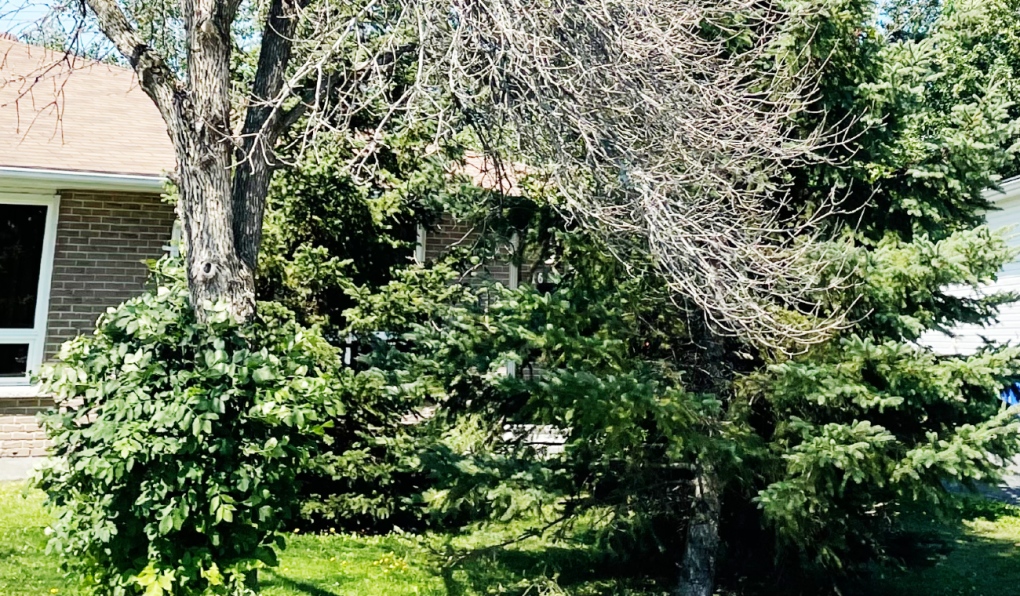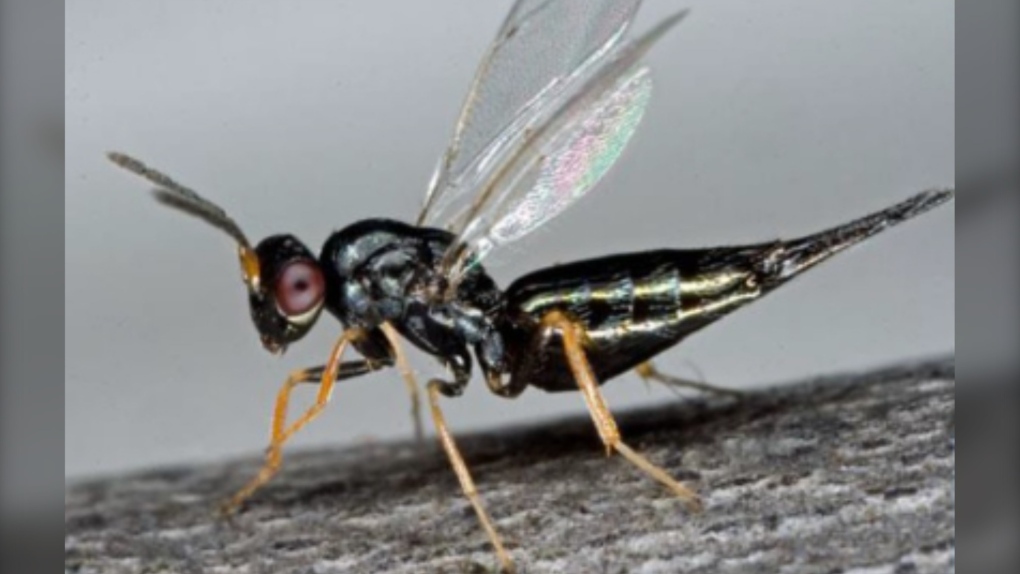Emerald ash borer invades northern Ontario, destroying ash trees along the way
A study released last week found that more than 35,000 invasive species have spread across the globe, with 3,500 considered to be harmful.
While invasive species such as the Zebra mussel and the murder hornet grab headlines, many cities in northern Ontario are dealing with the tree-destroying emerald ash borer.
First reported in America around the turn of the century, the tiny beetle made its way here from Asia and is destroying ash trees as far north as Thunder Bay.
David Dutkiewicz, an entomology technician at the Invasive Species Centre in Sault Ste. Marie, said the emerald ash borer is a tiny, shiny green beetle that likely got here as a passenger on infected wood used for packaging.
“Basically from untreated packaging material that it made its way over to North America in the Detroit area,” Dutkiewicz said.
The beetle will infect any species of ash trees, he said, laying its larvae in the trunk. It’s particularly tough to catch it early because it can take two or three years before the effects are visible, as the larvae feed on the trunk.
“Once the infestation starts, the impact is basically tree mortality,” Dutkiewicz said.
“So you're looking at almost 100 percent mortality rate for ash trees.”
A telltale sign of infection is the presence of a cluster of new branches at the bottom of the tree, a result of the larvae preventing nutrients from reaching the top of the tree.
Since its arrival, Dutkiewicz said about 500 million ash trees have been destroyed in North America. That includes 36 U.S. states and five provinces: Manitoba, Ontario, Quebec, New Brunswick and Nova Scotia.
In northeastern Ontario, municipal crews in North Bay, Sault Ste. Marie and Sudbury keep track of infected ash trees and routinely remove them.
 These trees in the New Sudbury area have been infected by the emerald ash borer. Affected trees will often have green shoots sprouting from the trunk because nutrients can no longer reach higher on the tree. (Darren MacDonald/CTV News)
These trees in the New Sudbury area have been infected by the emerald ash borer. Affected trees will often have green shoots sprouting from the trunk because nutrients can no longer reach higher on the tree. (Darren MacDonald/CTV News)
Ash trees are a popular urban street tree, which has kept municipal crews busy.
“In Sault Ste. Marie, they had to remove all the trees on Queen Street because they were all ash trees,” Dutkiewicz said.
“In the City of Toronto, for example, I think they had to replace over 700,000 trees that were on city property.”
In North Bay, a city spokesperson said in an email that for the last four years, crews have been removing infected trees from parks and city properties.
“This includes approximately 50 trees this spring in areas including the waterfront and outside City Hall,” Gord Young said.
The city is replacing the ash trees with other species “to minimize any future invasive species-related risks,” Young said.
“To date more than 350 trees have been planted.”
IN SUDBURY SINCE 2019
Chris Sheehan, a city manager in Sudbury who deals with urban forest management, said the emerald ash borer has been in the community since 2019.
Sheehan said they have identified 1,130 infected ash trees, and about 425 have been removed so far, at a cost of roughly $1,500 per tree.
This year, they’re running a pilot project that will gauge the impact of removing 74 trees at once from an infected area.
“That'll give us a good heads up on, you know, the cost and the time and the process,” he said.
“The idea is that maybe it'll be more efficient to take on a whole bunch of trees at once rather than sort of piecemeal as you go along – that’s what we're trying to find out.”
Chris MacQuarrie, research scientist at the Great Lakes Forestry Centre in Sault Ste. Marie, said the emerald ash borer has slowly made its way north, but doesn’t appear as far north as Timmins just yet.
“It’s possible that it’s there and just hasn’t been detected yet,” MacQuarrie said.
“But as you move farther north, there just aren’t as many trees for them to eat.”
He said it spread quickly in southern Ontario in part because ash was such a popular street tree. In the north, it’s threatening the black ash tree.
“That’s the one we’re most worried about in northern Ontario,” MacQuarrie said.
 This parasitic wasp fights the emerald ash borer because its eggs feed on the beetle's larvae. (Supplied)
This parasitic wasp fights the emerald ash borer because its eggs feed on the beetle's larvae. (Supplied)
To combat the spread, one of the most promising strategies has been the introduction of insects to counter the emerald ash larvae. One is a parasitic wasp that doesn’t sting humans, but likes to lay its eggs on the EAB larvae. Once the eggs hatch, they feed on the larvae.
“There's another species that's very tiny wasp that actually attacks the egg of the emerald ash borer,” MacQuarrie said.
“They've been doing it for a little bit longer (in the U.S.) and they've been following the progress. The newest data says that they think they're seeing some success.”
In Canada, similar strategies are in much earlier stages, but hold out the hope of pushing back the invasion in the longer term.
While the emerald ash borer is a significant problem, it is only one of a growing list of invasive species that we’re dealing with, MacQuarrie said.
Species such as the Hemlock woolly adelgid (which kills hemlock trees), the spotted lanternfly, southern pine beetle and the Asian long-horned beetle – to name a few – have made their way to North America to cause havoc.
Longer term, MacQuarrie said climate change can make the problem worse because it creates new areas where the invasive species can thrive.
That’s because of what’s called a ‘climate envelope’ – a set of conditions required for a species to survive. As the Earth warms, new areas open up.
“If they get introduced into a place that has a similar climate, the odds are that they'll successfully establish,” he said.
- Download the CTV News app now and get local alerts on your device
- Get local breaking news and updates sent to your email inbox
As the summer is ending, MacQuarrie said an effective way to prevent the spread of invasive species is to not move firewood, which can be home to a range of insects.
“So don't move firewood,” he said. And, you know, make sure that you're buying local plants at nurseries, that kind of thing.”
CTVNews.ca Top Stories

Poilievre suggests Trudeau is too weak to engage with Trump, Ford won't go there
While federal Conservative Leader Pierre Poilievre has taken aim at Prime Minister Justin Trudeau this week, calling him too 'weak' to engage with U.S. president-elect Donald Trump, Ontario Premier Doug Ford declined to echo the characterization in an exclusive Canadian broadcast interview set to air this Sunday on CTV's Question Period.
Man who died trying to help stranded motorist identified as Khalid Farooq, father of 5
The man who lost his life trying to help a stranded motorist Wednesday has been identified as Khalid Farooq.
W5 Investigates 'I never took part in beheadings': Canadian ISIS sniper has warning about future of terror group
An admitted Canadian ISIS sniper held in one of northeast Syria’s highest-security prisons has issued a stark warning about the potential resurgence of the terror group.
Great Lakes, Plains and Midwest forecast to be hit with snow and dangerous cold into next week
The first big snow of the season threatened to bury towns in New York along lakes Erie and Ontario during a hectic holiday travel and shopping weekend, while winter storm conditions could persist into next week and cause hazards in the Great Lakes, Plains and Midwest regions.
Are scented candles bad for you? What the science says
Concerns about the safety of candles are rooted in the chemical reactions that occur when you burn them, as well as in the artificial fragrances and colorants that contribute to the various scents you may love.
Trudeau talks border, trade in surprise dinner with Trump at Mar-a-Lago
Prime Minister Justin Trudeau discussed border security and trade during a surprise dinner with U.S.-president elect Donald Trump at Mar-a-Lago in West Palm Beach, Fla. on Friday evening, according to senior government sources.
North Korea's Kim vows steadfast support for Russia’s war in Ukraine
North Korean leader Kim Jong Un vowed his country will “invariably support” Russia’s war in Ukraine as he met Russia's defense chief, state media reported.
Montreal researchers make breakthrough discovery in fighting HIV
Researchers in Montreal have made a breakthrough discovery in HIV research by finding a way to expel the virus from its hiding places and destroy it.
'Very alarming:' Online scams spike during the holidays
Shoppers are out looking for the best deals on gifts for their loved ones. However, the RCMP and the Better Business Bureau are warning people that the deals they’re seeing online might be too good to be true.

































